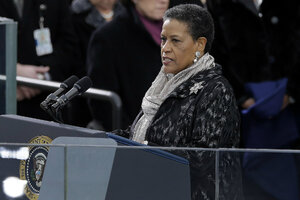It's not just an inauguration, it's a day of symbolism and stagecraft
Obama's inaugural address invoked the syntax and themes of Martin Luther King Jr.'s 'I have a dream' speech, and, on the 150th anniversary of the Emancipation Proclamation, the president took the oath of office on Bibles used by Lincoln and King.

Myrlie Evers-Williams delivers the invocation at the ceremonial swearing-in for President Obama at the Capitol during the 57th Presidential Inauguration in Washington on Monday.
Carolyn Kaster/AP
Washington
On a day already steeped in national symbolism, Barack Obama added a few more iconic touches for his second inaugural – moments of high political theater meant to illustrate the president's values and priorities.
Of course, as the first black US president, he adds a powerful symbolic element to the day simply by showing up.
Many in the largely black crowd on the Mall said they braved the horde so that their children could have the experience of seeing the president.
“It’s a life-changing experience," says Michelle Brown, a Detroit public schoolteacher, who spent a long day with a busload of 14- to 17-year-old students to get here. The first election of a black president was historic, she says, but the second is “awesome.” “Our children can see that anything is possible.”
For the second time in American history, a presidential inauguration fell on Martin Luther King Jr. Day. But it also fell on the 150th anniversary of the Emancipation Proclamation and the 50th anniversary of the March on Washington, whose iconic moment took place at the far end of the National Mall with the Rev. Dr. King’s “I have a dream” speech.
Mr. Obama invoked the syntax and themes of that speech in his own address, as he referred to “all those men and women, sung and unsung, who left footprints along this great Mall, to hear a preacher say that we cannot walk alone; to hear a King proclaim that our individual freedom is inextricably bound to the freedom of every soul on Earth.”
“It is now our generation’s task to carry on what those pioneers began,” he added.
Team Obama amplified this coincidence of calendar and inauguration at key points throughout the day. One was the choice of the Lincoln and Martin Luther King Jr. Bibles for the swearing-in. The Lincoln Bible had been used only once since President Lincoln used it for his first inaugural – and that was by Obama during his first inauguration. The King Bible had never been used during an inauguration.
Another was the invitation to Myrlie Evers-Williams, widow of slain civil rights activist Medgar Evers, to deliver the invocation. The author of three books on civil rights, she famously won a 30-year fight to bring her husband’s killer to justice in 1994. “We celebrate the spirit of our ancestors,” she said. “They are a great cloud of witnesses unseen by the naked eye.”
This theme, that there is a connection between the Obama presidency and the sum total of the civil rights movement that preceded it, is one promoted by the White House and reinforced by what has come to be known as Barack Obama art. Just off the Mall, hundreds of vendors sold all manner of offerings, including the iconic “Dreams of Change” by Michael Eaton. In this poster, Obama is seen taking the oath of office surrounded by Medgar Evers, Abraham Lincoln, Rosa Parks, Frederick Douglass, Harriet Tubman, Sojourner Truth, Thurgood Marshall, Martin Luther King Jr., John Kennedy, Roberrt Kennedy, Jackie Robinson, Malcolm X, and W.E.B. DuBois.
“Usually, the second inauguration is not memorable, but this one was very powerful symbolically,” says Julian Zelizer, a historian at Princeton University in Princeton, N.J. “What could be more exciting than to have an African-American president standing on the same Mall where Martin Luther King led a fight for racial equality,” he adds. “To have him there was a stirring success.”
Adds Mr. Zelizer: “It was also powerful because it was a reelection: Americans confirmed the decision. They had four years and they wanted him again.”
In a last powerful gesture, the parade down Pennsylvania Avenue included a float to honor the famed Tuskegee Airmen, an all-black unit who served with distinction during World War II at a time when the US military was still segregated. Several of the last surviving members sat as honored guests of the president, watching the parade.

